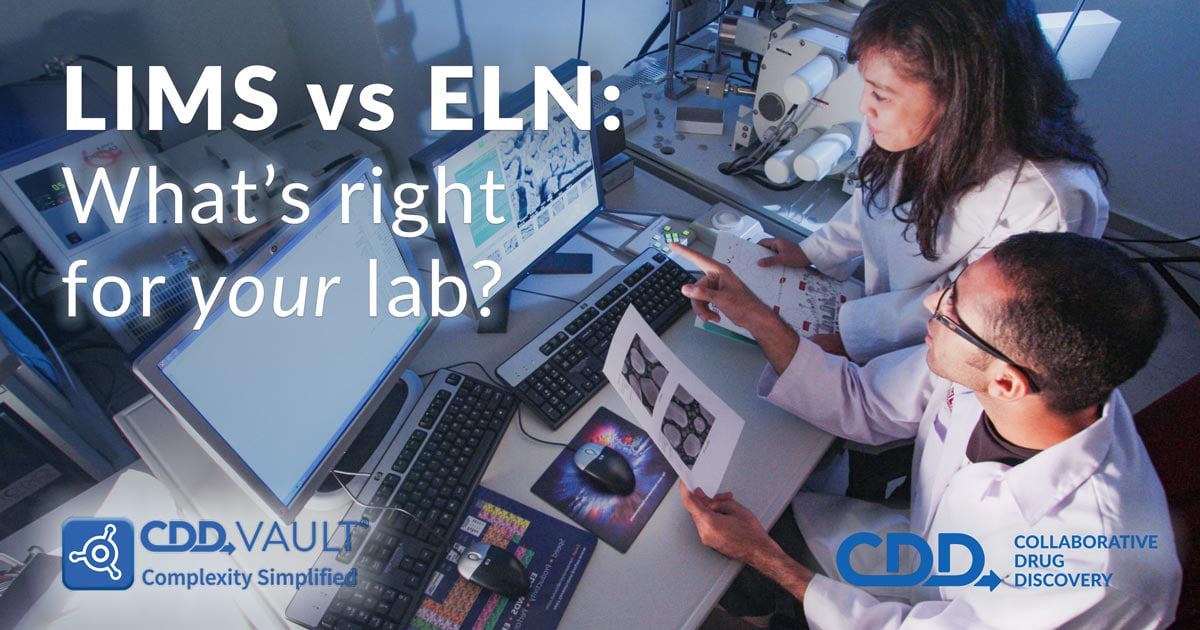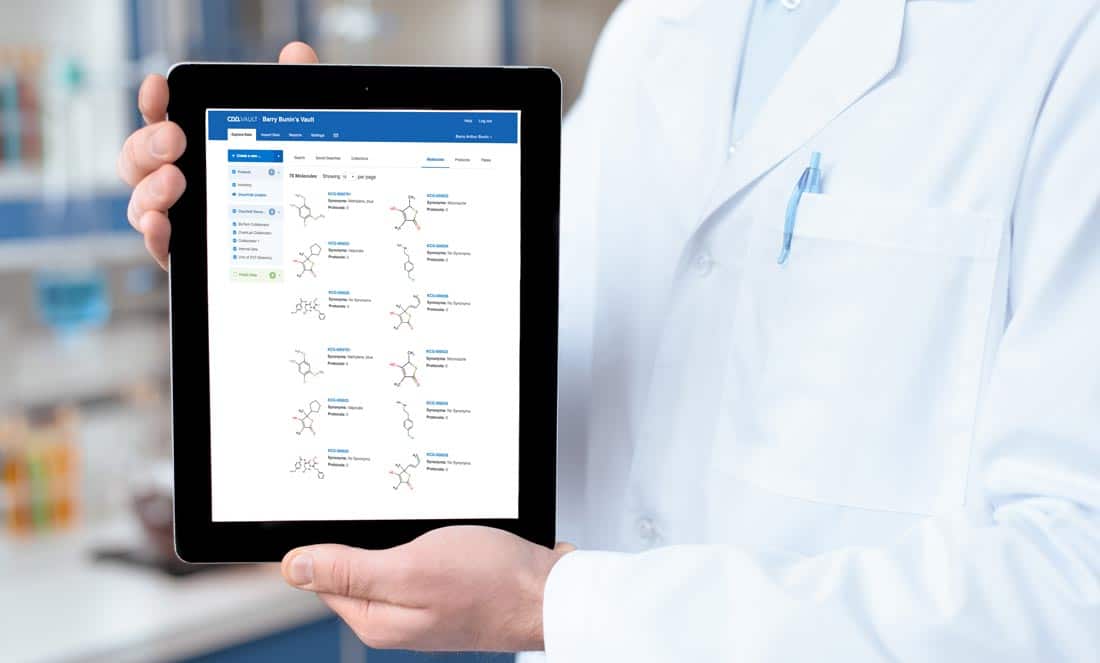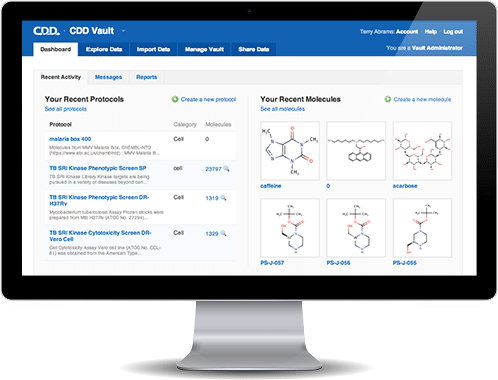
Author: Barry Bunin, PhD
Researchers often come to us unsure whether a LIMS or an ELN is right for them. Here is a guide to understand what a LIMS is, and how it differs from other scientific data management systems.
Rather talk to a human? Contact us today to get a free consultation with our experts. We can help you explore the right information management solution for your research organization.
See also: ELNs - what they are and why you need one
Is a Laboratory Information Management System (LIMS) right for you?
In the lab, being able to run research experiments and get results on time is crucial in today's fast-paced world. Furthermore, in many cases labs need to be able to give a third-party - say a regulatory body- detailed information about what happens to samples from the time they arrive in the lab until the reports were created and sent and the client invoiced. Timely, accurate, and replicable processes and protocols play an important role in helping labs across different sectors, including drug discovery and development, do their research well and maintain their reputation in the market. Laboratory Information Management Systems or LIMS are tailor-made to help labs accomplish these goals efficiently and effectively. These systems are designed to support multiple projects and users in various laboratory types from biopharma all the way through to biofuels and manufacturing.
What Is a Name?
The definition of LIMS is in its name. Essentially, these systems automate and streamline the process of collecting information and managing tasks in laboratories. In the pharmaceutical context, these systems let users track samples and information associated with the samples from the moment they enter the lab through experimentation through to the final report. These systems store information such as inspection number, batch material, time and date when the sample was entered, what tests were done, and so on. These are simple pieces of data to collect but they are critical to ensuring the quality of the lab process, especially in a GxP-regulated environment.
The need for proper data and sample tracking is especially important in today's high-throughput research environments. Labs increasingly need to store and track large quantities of experimental data for longer periods of time. Labs routinely run experiments on hundreds or thousands of samples. That coupled with the increasing complexity of drug discovery data makes less automated methods of data tracking like spreadsheets untenable.
In addition to reducing the administrative burden of running a lab, LIMS reduces the risk of human error during data collection and tracking. LIMS solutions can catch errors in workflows and ensure that lab protocols are being followed to the letter. Multiple people in a lab can access and view the same workflows and results using a single system. Furthermore, these systems are required to comply with various government regulations. As such labs can be sure of the quality of their output and that the processes used to get to those results adhere to appropriate regulations and standards for their field.
A Brief History of LIMS
LIMS have become increasingly complex to meet the demands of high-throughput labs. But they weren't always that way. The earliest commercial LIMS solutions came to market in the 1980s developed by companies like Perkin-Elmer although its roots can be traced back to laboratory automation products of the 1970s. Conferences focused on LIMS soon followed and a non-profit body, the LIMS Institute, emerged to support the fledgling community by providing a forum for sharing information and ideas.
Today's LIMS have evolved far beyond those early systems which often required significant customization to meet labs needs and experienced challenges with exchanging data between systems. From their earliest days as basic data entry and record storage systems, commercial solutions offer a range of complex functionalities and features and can be deployed on in-house infrastructure or hosted on the cloud. They have also become increasingly flexible and adaptable to support a host of bespoke needs and requirements. Furthermore, companies have begun to incorporate capabilities that were historically not part of the LIMS repertoire, helping to increase the versatility of these solutions and blurring the boundary between LIMS and other types of data management systems.
What LIMS Do
The primary function of LIMS solutions has remained largely stable through the years - to track and store information about a sample from the time it is brought into the lab. It works behind the scenes to make sure that the lab workflow runs smoothly, the right data is captured, and that proper lab processes and protocols are followed consistently.
Broadly speaking, commercial LIMS offer the following core functionality:
- Sample, inventory and data management:When samples come into the laboratory, they are logged and registered in the system including any customer data associated with the sample as well as the time and date the sample was brought in. The LIMS also assigns the sample a unique identifier, for example, a unique barcode that is attached to the sample and used to track it through the lab whether it's on a shelf in the freezer or being processed by a mass spectrometer. LIMS can also be used to maintain inventories of reagents and other lab resources and materials including details like expiration dates, storage requirements for samples and reagents, and quantities of supplies.
- Instrument integration and Workflow Management: LIMS can connect to laboratory instruments and applications making it easy to pass along information about a sample and launch experiments directly from the software. These solutions can also automatically assign tasks related to a sample, let researchers know where samples are supposed to go, and suggest instruments that are appropriate for a given experiment. During experiments, LIMS can monitor instrument runs, and flag errors or problems when they occur. Labs can also use the system to prioritize runs and perform batch runs. Lastly, LIMS can import results from experiments into analysis software for analysis and interpretation or send the sample on to other instruments for further testing.
- Quality and Compliance: These systems provide centralized access to quality control data. For labs that need to meet specific regulatory requirements, LIMS can provide audit trails for samples and data as well as quality control and quality assurance information.
Other functionality included in the LIMS solutions on the market today include chain of custody, custom reporting functionality, role assignment, task management, electronic signatures, supply management, instrument maintenance, customer invoicing and billing, and much more. Individual vendors may even offer additional proprietary functionality or unique features in their solutions. In addition, most vendors let users customize their systems to their specific needs.
What LIMS Can't Do
Although LIMS solutions today are very flexible and can be adapted to suit various needs, these systems are primarily designed to support structured workflows and data. This makes them very well suited for environments that have consistent or repetitive activities. They are also very sample-centric meaning they focus primarily on capturing information around the sample and what happens to it including things like sample ID, what tests it will undergo as well as any reagents and instruments needed. For capturing the details of experiments, such as observations and unstructured research notes, slightly different functionality is required.

LIMS vs ELN and Other Systems
Electronic Laboratory Notebooks are often confused with LIMS solutions although the latter were developed first. While it is true that these systems share some capabilities and there are cases where either one will work for the tasks that a lab needs, there are some noted differences. The oft highlighted difference between the two is that while LIMS typically follow pre-defined generalized workflows defined at the level of lab management, ELNs tend to be more personalized and flexible to change by individual researchers. This distinction makes sense in the context of regulated environments where LIMS are needed to support the tightly regimented workflows and structured data required in these spaces. With their more fluid nature, ELNs may be better suited for research and discovery environments where changing workflows and unstructured data are more of the norm.
Furthermore, unlike ELNs, LIMS are specifically designed to simplify the task of tracking and locating samples, reagents, and chemicals when needed. The importance of this functionality becomes clear if we imagine a researcher running an experiment and recording their processes and capturing data in an ELN, who suddenly needs to locate a specific reagent in storage. In this scenario, having access to an integrated LIMS/ELN platform can keep the experiment moving forward seamlessly and without unnecessary delays.
Another system which sometimes gets confused with a LIMS is a Laboratory Information System or LIS. LIS were initially designed for use in clinical and forensic settings and include specific functionality for capturing and reporting data related to people rather than samples. It is also important here to distinguish LIMS from compound registration systems such as Chemaxon, Arxspan, Dotmatics Register and CDD Vault. These solutions have LIMS-like functionality including registration, ID number assignment, and tracking capabilities, but they are designed specifically to capture, register, and organize structures and activities at the chemical/biological compound level, rather than the sample level.
However, the lines between all these systems are increasingly fluid. Some LIMS solutions offer LIS like functionality for capturing patient data that can support diagnostic labs, for example. Some vendors even merge both LIS and LIMS systems into a single infrastructure. The same holds true for LIMS and ELNs as well as for LIMS and compound registration systems. These days, it is also not uncommon for commercial vendors to offer integrated platforms that pair the capabilities of multiple solutions. Or for some systems to include functionalities from others. For example, some ELN solutions include LIMS functionality like sample management capabilities. Some LIMS solutions can also function as ELNs because they include modules for capturing and sharing information related to experiments. Lastly all these systems include reporting functionality that will present information in similar ways, for example, in spreadsheets, interactive graphs and plots, and so on.
Advantages of LIMS
- Easy Administration: These systems take the guesswork out of sample administration and management, and they cut down or eliminate paperwork. Moreover, they streamline laboratory processes from start to finish improving productivity and shortening time to results.
- Saving Money: By making lab processes and workflows more efficient and automated, these systems can result in significant time and cost savings across the board. They also free members of the lab to focus on tasks that add value to the business rather than wasting time searching for mislabeled samples or tracking the provenance of a sample or experiment. In a fast-moving field, those extra minutes can add up to large savings over time.
- Everything in a single standardized system: Teams don't have to waste time searching for or tracking information contained in multiple systems because they have access to everything from a single system. Furthermore, as noted above, for labs that work in regulated environments, LIMS can help ensure that their internal workflows meet the requisite quality control and quality assurance guidelines.
- Easy access: with internet connection possible in most locations around the world, members of a lab can access and review important information in their LIMS or launch experiments virtually.
- Integration with existing systems: It is standard practice for LIMS solutions these days to seamlessly integrate with third-party infrastructure already being used in the lab. That includes sequencing instruments, spectrometers, PCR machines, and more. In fact, many vendors of existing lab instruments also market LIMS as part of their product portfolios.
- Eliminates the need for expensive hardware: This is perhaps the most important benefit of cloud-based LIMS solutions. Furthermore, since the system is managed by the vendor, labs that go this route don't need hired dedicated IT personnel or purchase new hardware internally to support the solution.
LIMS in Pharma/Drug Discovery
Pharmaceutical labs often run a variety of high-throughput workflows that can involve multiple instruments, samples, and datasets. A single pharma company may house a wide range of laboratories operating at any given time, each with its own unique workflows, and handling everything from research and development and compound testing through to manufacturing. Furthermore, pharma companies are under increasing pressure to produce drugs more efficiently and within a shorter time frame.
LIMS can help improve efficiency and productivity through standardized and automated workflows and centralized data and instrument management. In the competitive drug discovery market, labs can be confident of the security and safety of any intellectual property stored in their LIMS. They can consolidate their reporting using these systems and ensure that their protocols and workflows hold up to regulatory scrutiny. Because LIMS vendors make it their business to stay abreast of technological developments, labs can adopt improvements in LIMS technologies relatively painlessly. Lastly, the easily customizable nature of LIMS makes them an attractive option for pharma companies seeking a single solution that, with some tailoring, can work for all their labs.
Do you need a LIMS?
Given the investment involved in implementing new infrastructure, some labs may be on the fence about getting a LIMS. But the return on investment that these systems offer over time can't be overlooked. There are some helpful tools for starting the process of computing what those numbers might be like this white paper from BioSoft Integrators on how to determine the ROI on LIM investment. For labs that are seeing increasing sample volume or looking to expand the kinds of experiments they offer to clients. In a world where time is money, LIMS help labs avoid wasting precious resources tracking down missing datasets or correcting errors in reports.
Before investing a solution, it is important to think about exactly what functionality is needed in the lab. If the primary need is a tool for sample management and tracking, then a LIMS solution may be the best option. However, if what is really needed is a tool that can manage unstructured lab data or track chemical compounds, then an ELN solution or even a compound registration software might be a better fit. As noted above, pharma companies often have multiple labs operating in-house. Depending on the needs of these different research groups, it might be useful to consider purchasing an integrated platform that offers combined access to a LIMS, ELN, and compound registration solutions.
Commercial vs Homegrown LIMS
Different LIMS are designed to meet unique needs. For example, one lab may need a system that offers significant data management functionality for handling data of different types. Another lab may need something that integrates functionality from multiple solutions such as a platform that combines the features of an ELN with LIMS.
Labs considering LIMS solutions have their pick of companies selling hosted and/or on-premise solutions. And today's vendors have come up with creative ways to position their solutions. The one you pick will depend on your lab's needs, number of users, and price point among other factors. Moreover, some LIMS solutions are developed for clients in specific market segments that have unique needs such as molecular diagnostics labs.
Most commercial LIMS today can be configured to meet individual customer requirements and are easy to use. These solutions work well with many of the common instruments found in pharmaceutical and other kinds of labs. The exact price points and subscription models vary from one vendor to the next. Different systems also require different kinds of infrastructure in order to run. Some of the systems currently available in the market include:
- BaseSpace Clarity LIMS
- LabWare LIMS
- Sunquest Mitogen LIMS
- STARLIMS
- LabVantage
- Exemplar LIMS
- Core LIMS
- SampleManager LIMS
- SLIMS
Some commercial platforms combine multiple functionality. For example, the LabVantage system combines the functionality of LIMS with those of an ELN and a Laboratory Execution System. For its part, Exemplar LIMS combines LIMS functionality with ELN and Scientific Data Management System capabilities. Lastly, SLIMS, which is developed by Agilent, integrates LIMS and ELN functionality. A more complete list of LIMS solutions can be found here.
In addition to reviewing the available solutions on the market, there are some labs that opt to design and develop their own LIMS in house. Armed with the right programming team and a detailed listing of the lab protocols and workflows, it's certainly possible to craft a system that will be uniquely tailored to the needs and specifications of the lab. It may even be less of a financial burden to develop a system internally than investing in a commercial option.
But programming a LIMS takes time and requires an almost encyclopedic knowledge of the lab's workflows and protocols to properly develop the needed functionality. Moreover, lab needs may change all the time and technological developments happen quickly. By the time the system has been built, it may already be outdated. Moreover, the lab and their programming team have sole responsibility for maintaining the system and fixing it when something breaks. There may also be challenges with getting different pieces of software to talk to each other let alone the other instruments in the lab.
Labs may also run into problems if the programmer or programming team turns over and takes their knowledge of the system with them. Lastly, regulated labs that decide to make their own systems will have to shoulder the responsibility and costs of going through any appropriate validation processes and approvals required by regulatory authorities in their field. Getting systems approved in this context is both time intensive and difficult. What started out as a cost saving strategy may end up being prohibitively expensive.

Important Considerations
Whether the goal is to purchase a LIMS for the first time or to transition from a legacy solution to a newer, more advanced one with greater functionality, there are a few things to think about:
- Financial and time considerations: One of the bigger barriers to getting a LIMS may be the cost. Once the decision is made to invest in a system, there are costs associated with deploying the system, licensing fees, customizations to meet the needs of the laboratory and workflows, ongoing technical support, and ongoing system maintenance. There's also a significant time investment in getting staff trained to use the platform and moving existing data into the new system. These costs may end up being worth it to the lab in the long run, but the initial investment can be quite steep. The quickest way to become frustrated is to have an expensive system lying dormant because the funds for its upkeep ran out. Or to have a system that's not used enough to justify the expense. For small to mid-sized laboratories, cloud-based solutions may be a better fit from a cost perspective. Lastly, limiting customization to only essential protocols can be an effective cost cutting measure, but it does mean that there may be some manual steps that the lab will still have to do.
- Features: The list of commercial LIMS solutions provided above is by no means exhaustive. There are many more systems of the market each offering their own rich set of features and functionality. Identifying the right combination of features for a lab's needs can be challenging and overwhelming. The best tactic for avoiding confusion is to list all desired features and functionality before starting to explore available options. This helps narrow the field of feature options and ensures that the lab isn't swayed into purchasing extra functionality they don't really need. This also helps the lab avoid purchasing a solution that isn't the right fit for the task, for example, buying a LIMS for managing unstructured lab data when what is really needed is an ELN.
Creating a features list is also helpful for comparing different solutions on the market to identify the best fit for a given lab's needs. Some vendors offer checklists that can be used to help labs assess whether their LIMS is a good fit. - Buy-In from management and laboratory staff: Approaching management with a request to invest in a LIMS solution is necessary for securing a budget and long-term support for the infrastructure. But equally important is ensuring that the people who will use the system on a regular basis are aware of the proposal. Basically, there should be consensus in the lab about the value of the system, the decision to purchase a particular system, and the team should be willing to use it once it has been installed. It is important for lab managers to allow their teams share concerns about the new infrastructure as well as any previous experiences with LIMS. All of this is valuable information that can inform the system that is ultimately chosen. It will also help make the transition smoother because staff can think through how their job responsibilities and daily tasks will change once the system is implemented.
- Not a perfect fit: Though LIMS solutions are becoming increasingly technical and intricate in the features that they offer, these systems may not perfectly match all the lab's needs. Vendors can make customizations. But there is a limit to how much flexibility these systems can tolerate since different labs have unique requirements and analysis specifications. Even within the same company, labs may be using the same LIMS in different ways. And any changes will need to be factored into the costs of the system and can extend the implementation time of the system significantly.
Conclusion
LIMS can be a valuable addition to any lab but particularly for labs that work with large numbers of samples and data. Not only do they improve operational efficiency, these systems also reduce the risks of human error and ensure that the integrity of samples and any associated data is maintained throughout the lab process.
Keep in mind though, that the world is different today from when the early LIMS were first developed and used. Much of the functionality that exists in today's systems evolved organically out of industry need while other types of systems like ELN, LIS, and compound registration offer alternative approaches to managing laboratory data. Instead of getting overwhelmed with choices, it's important to have a clear picture of the essential functionalities you are looking for and find the system that matches your needs.
For a powerful data management system with fully integrated compound registration, inventory, ELN, and data visualization, check out CDD Vault.
References
-
Why Is LIMS Important for Manufacturing Companies? https://www.thebalancesmb.com/laboratory-information-management-systems-lims-2221211
- Gibbon, G. A. (1996). A brief history of LIMS. Laboratory Automation & Information Management, 32(1), 1-5. doi:10.1016/1381-141x(95)00024-k
- What is a LIMS and What is it Used for? https://www.mynewlab.com/blog/what-is-a-lims-and-what-is-it-used-for/
- What is a LIMS? https://cloudlims.com/blog/what-is-a-lims.html
- What is a LIMS? https://www.illumina.com/content/dam/illumina-marketing/images/informatics/what-is-lims-infographic-web.pdf
- LIMS vs ELNs - Arch enemies or best of friends? https://www.ddw-online.com/informatics/p146753-lims-vs-elns-arch-enemies-or-best-of-friends.html
- 4 Reasons Why You Don't Have LIMS and Tips to Overcome Them https://www.broughtonsoftware.com/blog/4-reasons-why-you-dont-have-lims
- Cost of LIMS: True Pricing Includes more than Purchase, Implementation, and Annual Licensing https://www.rdworldonline.com/cost-of-lims-true-pricing-includes-more-than-purchase-implementation-and-annual-licensing/
- ELN vs. LIMS? https://www.csolsinc.com/insights/published-articles/eln-vs-lims/
- What is a LIMS - a laboratory toy, or a critical IT component? https://web.archive.org/web/20131004232754/http://www.rsc.org/pdf/andiv/tech.pdf
- Laboratory information management system wiki. https://www.limswiki.org/index.php/Laboratory_information_management_system#cite_note-SapioWhatIs10-1
- Choosing a Cost Effective LIMS for Your Lab https://caredatainfo.com/how-to-choose-a-laboratory-information-system/
- Sure-shot signs that you need a LIMS. https://caredatainfo.com/upgrading-to-new-lims/
- ELN, LIMS, CDS, LES: What's the Difference? https://www.technologynetworks.com/informatics/articles/eln-lims-cds-les-whats-the-difference-313834
- 5 steps to go paperless: ELN and LIMs. https://blog.labcollector.com/5-steps-choose-digital-solution-elns-lims/
- Machina H.K.; & Wild D. J. Laboratory Informatics Tools Integration Strategies for Drug Discovery: Integration of LIMS, ELN, CDS, and SDMS. Journal of Laboratory Automation, Volume: 18 issue: 2, page(s): 126-136. https://journals.sagepub.com/doi/10.1177/2211068212454852
- Managing New Science: Case Studies. https://www.coreinformatics.com/pharma-rd/managing-new-science#case-study-1
- An overview of LIMS in the pharmaceutical industry. http://www.pharmtech.com/overview-lims-pharmaceutical-industry
This blog is authored by members of the CDD Vault community. CDD Vault is a hosted drug discovery informatics platform that securely manages both private and external biological and chemical data. It provides core functionality including chemical registration, structure activity relationship, chemical inventory, and electronic lab notebook capabilities.




